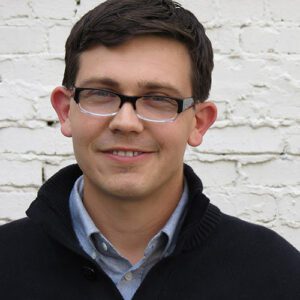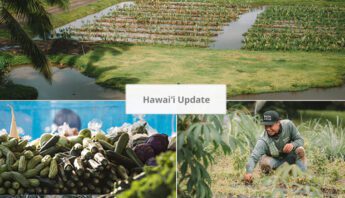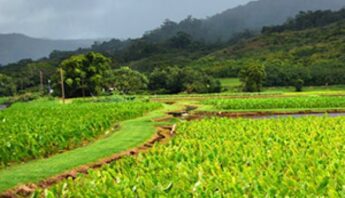First steps are meaningful, depending on context. When my now 15-month-old took her first steps earlier this year, we celebrated her progress. It was a major milestone in her early life. But Hawai’i regulators don’t deserve the same kudos for their recent announcement intended to quell concerns about pesticide use on the islands.
For more than a decade, the Hawai’i Departments of Health and Agriculture have ignored the threat of pesticide exposure facing communities, workers and children — and have instead proposed superficial next steps.
Sidestepping the “silent pandemic”
Extractive farming on Hawai’i — most recently genetically engineered (GE) seeds bred for export — is often linked with heavy pesticide use. Time and time again, regulators in the state have chosen to focus on large-scale pesticide drift incidents, rather than the “silent pandemic” of health harms facing communities (particularly children) living near agricultural fields.
Luckily, major drift incidents like what happened at Waimea Canyon Middle School, or more recently near a Syngenta operation on Kaua’i, don’t happen every day. But they receive the most attention from regulators. What gets overlooked — and what’s documented in PAN’s recent report, Kids on the Frontline — is the growing link between very small amounts of pesticides and serious damage to children’s health and cognition — including developmental disorders and increased rates of childhood leukemia and brain tumors.
Hawaiian advocate Walter Ritte put it like this:
Long-term exposure is the curse we live with on Moloka’i. Ho’olehua homesteaders, Molokai High School, Kualapu’u Elementary School, Kualapu’u Town, Molokai Irrigation System [sic]. The reefs of our one of our best fishing grounds in Pala’au below the GMO fields. All of which have been shown to the head of the Department of Ag years ago and to the governors chief of staff. . . no response.”
Pesticides like chlorpyrifos, atrazine and paraquat have specifically been linked to neurological impacts, hormone system impacts and Parkinson’s disease respectively — and they are regularly and repeatedly used on the islands. These chemicals end up in the air and water, and in the bodies of those living nearby. What’s more, paraquat and atrazine — both manufactured by Syngenta — are banned for use in their home country, but allowed in Hawai’i and the rest of mainland U.S.
Digging into details
The new policies just proposed by the state Departments of Health and Ag fail to address the real problems facing Hawaiians: a system of land use that has perpetuated industrial farming practices, abused water and biodiversity, and failed to support farming for local consumption. Parents, health professionals, teachers and others are pressing state decisionmakers to act with urgency and restrict harmful pesticide use to help create a sustainable food and farming system throughout the state.
Many of these current smaller-scale gaps were outlined in the comprehensive Joint Fact Finding report, commissioned by the County of Kaua’i, in response to a related ordinance passed by local government.
But the JFF report also made some larger recommendations, including: “Carefully establish new state standards for ‘Chronicity’ to account for low-level continuous exposures” and “undertake a major update of Hawaiʻi’s pesticide laws and regulations.”
Among other things, the new state agency joint plan doesn’t (and should) include the following:
- Require mandatory pesticide use reporting for all agricultural pesticides. The so-called Good Neighbor Program is voluntary reporting by companies for restricted-use pesticides, and some companies in press reports are saying that they may all participate come January. But even then, it ignores many general use pesticides that are still harmful.
- Create protective, consistent no-spray buffer zones around sensitive sites. Children at schools and in homes, for example, deserve additional protections. Similar to the above, companies may agree not to spray pesticides within 100 feet of schools as part of the Good Neighbor Program, but even if they comply, many pesticides travel far greater distances through the air, and the current rules wouldn’t even apply to non-restricted pesticides.
- Establish a comprehensive air monitoring program. States like California already maintain an air monitoring program near sensitive sites like schools and homes, and Hawai’i should do the same.
- Initiate a polluter pays fee. As noted in the JFF report, DOA and DOH (taxpayers) shouldn’t shoulder the burden of pesticide use. New pesticide fees assessed on pesticides, as already done in California, should pay for investments in local farmers and green, cutting-edge practices.
Despite the major shortcomings of the plan, a few noteworthy components (mostly focused on acute, immediate exposure) include:
- Water monitoring. The U.S. Geological Survey is leading a $500,000 water quality sampling project on Kaua’i and Oahu, to assess some of the threats — although the project appears to ignore Maui County, where Monsanto maintains its largest operations.
- Training for clinicians on recognizing pesticide poisoning. The inability of physicians to recognize pesticide-related illness because it isn’t a required component of medical training. Equipping health professionals can help address immediate threats and get people the care they need.
- Interagency response to emergencies. State agencies can and should have better coordination when an emergency arises and be able to address any major pesticide threat.
Local government (voices) squelched
This summer, federal courts disappointingly ruled that based on a read of current law, only Hawai’i state agencies can set the bar for regulation of pesticides (and further clarified that this is just based solely on Hawai’i statute so any state has the power to grant local governments the ability to regulate pesticides). When local governments in Kaua’i, Mau’i and Big Island passed laws in recent years to protect their residents, global pesticide corporations sued to block them. That’s why it’s ever-more important that the state take leadership on monitoring and restricting pesticides, as well as support more significant changes to land use and water that promote truly sustainable and fair agriculture.
Fern Ānuenue Rosenstiel, Kauaʻi resident and co-founder of ʻOhana ʻO Kauaʻi summarized that point shortly after the verdict:
[The] ruling violates our rights as humans to clean water and air, and our ability to protect our people and environment. As we continue to fight, we will push even harder for the state to take immediate action. We have waited far to long for better regulations and protections and we must fight harder than ever for justice.”
Baby steps aren’t enough.








